Whether you’re selling websites, marketing campaigns, consulting, or anything else in the digital services space, there is one thing everyone MUST be keeping tabs on… that’s ensuring your business is successful and sustainable. That’s right, folks, we’re talking profit margins.
Apologies. Of course you already know the importance of profit margins – you’re an agency owner – duh! And you obviously know how best to calculate them. Right? Right…?
OK, in general terms; we may go ahead and take our revenue, minus the costs, and divide it by the revenue. That would be a standard formula for profit margins. However, it’s a little more complicated than that – especially when discussing digital agencies.
You’re probably asking yourself:
- What does a ‘good margin’ look like?
- How do I know if my margin is healthy?
- How can I actually calculate it?
- Can I change it, if I’m not happy with it?
If those questions are on your mind, you’re in the right place. Let’s get right into it.
What Is Agency Profit Margin?
We look at two main profit margins – Delivery Margin & Operating Margin. Hold up; there are some other common aliases they may be lurking under:
- Delivery Margin: AKA Gross Margin or Contribution Margin
- Operating Margin: AKA Net Margin, Profit Margin, Operating Income
These margins are used to assess the health of your digital agency. They can help aid in decision-making – such as pricing, team composition, service offerings, and more. They can also be a useful tool in the M&A process, to determine your agency’s value. As you know, a company that isn’t profitable, won’t receive a high valuation (find out what your marketing agency is worth using our valuation calculator).
Digital Marketing Agency Profit Margin Benchmarks
So, where should you ideally be operating at? What would be considered a ‘good’ margin? And, on that topic, what do other agencies perform at?
A high-performing agency would be hitting a 50-60%+ Delivery Margin on the Profit and Loss statement. The general goal we set for clients is to target anything over 50%. Once that’s achieved, you’re looking ‘good’. Really, it’s the optimum measure of just how efficiently your team earns agency revenue, and therefore the foundation for profitability in any service-based business.
As for Operating Margin; we’d view a ‘high performing agency’ hit 20-30%+ on the P&L statement. If that sounds high, trust us, it’s totally possible – with the right structure in place. Typically, any Operating Margin over 15% would be considered acceptable in our books.
The Importance of a Healthy Profit Margin
Invariably, you won’t be surprised to hear this… having a healthy profit margin is, well, critically important. However, it goes a little deeper than merely having a profitable ad agency, creative agency, marketing agency, or business in general.
A healthy profit margin compensates the founders for the risk they’ve taken on for ‘X’ number of years. It also bears fruit for everyone involved, giving team members competitive salaries, a stable job, room for growth in education, benefits, and so much more.
This might sound weird, but healthy profit margins also benefit your clients. It allows you to make decisions about serving clients during extenuating circumstances in a way that isn’t heavily constrained by finances. It also tends to mean your clients can expect more consistent service in the long run, as small bumps in the road are less likely to crater your business.
How to Calculate Your Profit Margin
We’ve actually covered the agency profitability calculation part of this in another post of ours. Simply put, you need to tackle two separate calculations for Delivery Margin & Operating Margin.
For Delivery Margin, we’re looking at the following:
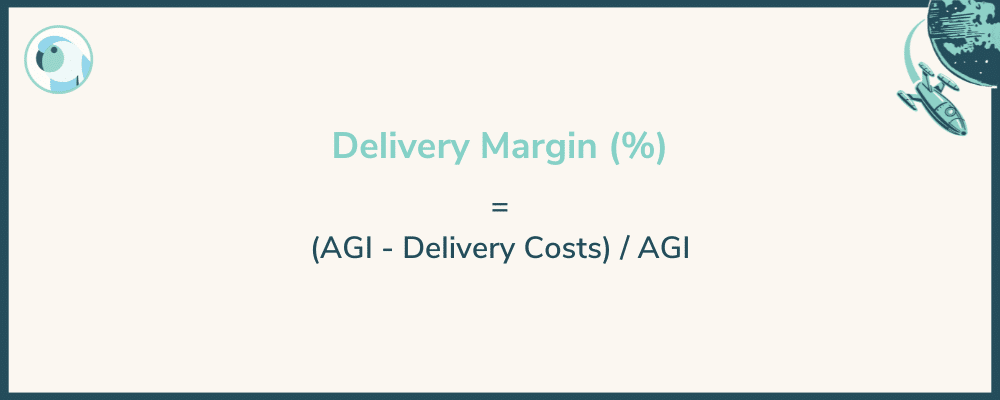
ㅤ
Where Delivery Costs are the cost of earning revenue (usually in terms of labor), and AGI is your total revenue minus your Pass-Through Expenses (often called COGS).
However, we’re uncovering another layer here. What defines a Pass-Through Expense, and how do you calculate your delivery costs (better yet, your employee cost-per-hour)?
Well, the way we view Pass-Through Expenses is to reverse engineer it; look at the amount of revenue from a project that actually belongs to you, and is earned by the work your team is doing.
Anything passing through your agency onto the client, such as stock photos, outsourced work, anything white-labeled – these are all pass-through. So, for instance, if your revenue on a project is $5000, but you spent $1000 on outsourced design work, you’d be looking at the following…
- The amount of revenue your team is responsible for earning: $4,000, this is your AGI
- The amount of revenue that passed through your agency: $1,000
Subsequently, your AGI is simply revenue minus pass-through expenses. Use this in your formula to calculate your Delivery Margin. Do keep in mind that you’re going strong if you’re keeping it over 50%.
Did you know? Parakeeto offers a totally free toolkit free toolkit where you can automatically generate your Delivery Margin and other profitability metrics using our Optimization Simulator. Here is what that looks like:
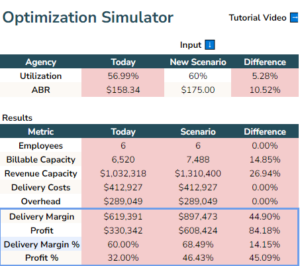
Now, when it comes to Operating Margin (AKA Net Margin or Operating Income), you’re simply viewing your ratio of Agency Gross Income (AGI) to expenses. This could also be viewed as EBITDA, that being earnings before interest, taxes, depreciation, and amortization. This is meant to represent the gross profit that your business generates from its regular operations after the cost of running the business has been accounted for. After all, you need to pay owners, administration, sales and marketing, rent, accounting…
Here is our formula:
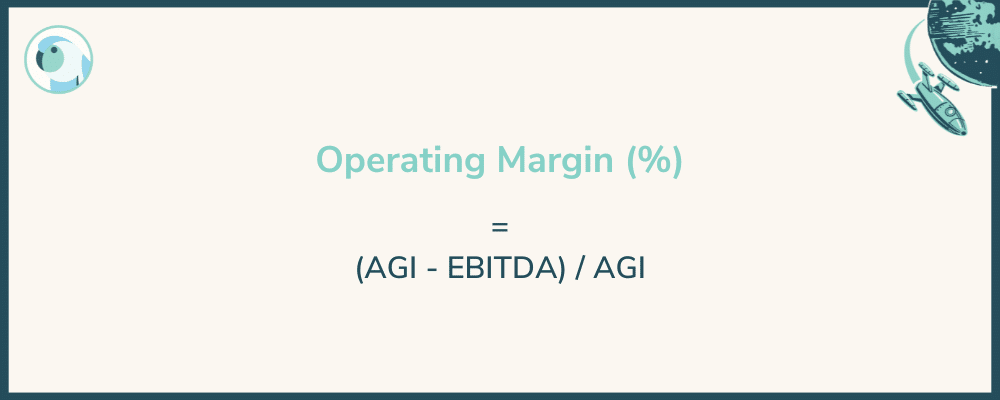
ㅤ
Remember, the target is 20-30%+ with 15%+ being reasonably healthy.
3 Tips to Improve Your Agency’s Profit Margins
Here are a few proactive things you can be beavering away on in the background to start edging your agency profitability margin closer to a healthy stance.
Tip 1 – Understand your two main levers
If you’re looking to improve the stability and longevity of your agency – and be more profitable in the process – then you need to start at your Delivery Margin. Without strong delivery margins, it’s extremely hard to be profitable. We’ve worked with hundreds of agencies over the past three years, and one thing consistently rings true: every agency we’ve seen struggling with profit was primarily grappling with delivery margin.
As a reminder, delivery margins (at their simplest level) come down to the ratio between the amount of AGI your agency is able to earn, and the amount of delivery costs it incurs to earn that AGI.
There are two levers you can utilize to improve your delivery margin:
- Increase AGI while maintaining or decreasing delivery costs
- Decrease delivery costs while maintaining AGI
Looking to increase your AGI?
The amount of AGI a given team is able to earn comes down to a simple equation:
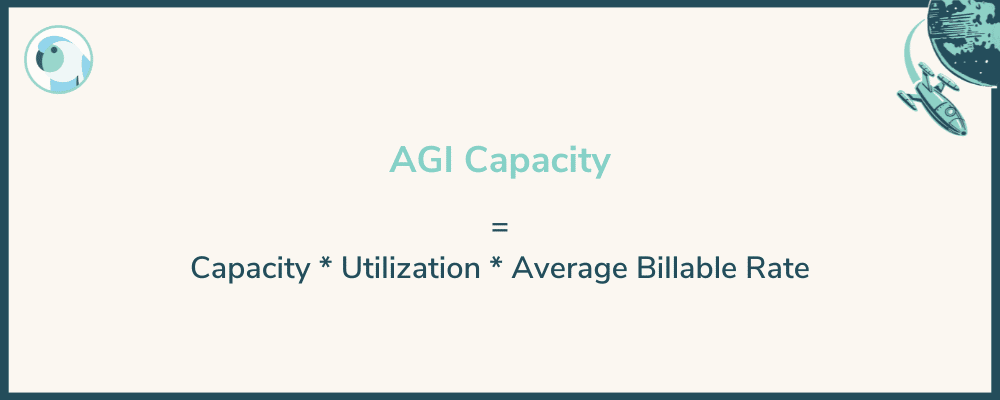
ㅤ
Therefore, the three options (or additional levers, if you will) to increase your AGI include…
- Increasing your team’s utilization
- Increasing your price without changing scope.
- Decreasing the time it takes for deliverables to get done while maintaining prices.
Looking to decrease your delivery costs?
Conversely, we have decreasing delivery costs, which really comes down to…
- Sourcing less expensive resources to do the same work as someone more expensive.
- Laying off staff members
Tip 2 – Revenue Replacement
Remember that profitability is a ratio, not an absolute value. What’s important is the ratio between the type of income your team is able to earn relative to what it costs to earn said income. There is no amount of agency revenue that absolves us from needing to keep that ratio in balance.
We see it time and time again; agencies that are doing millions in revenue but aren’t making any profit. Sometimes, they’re even losing money. These agencies are suffering from indigestion, which they often mistakenly perceive as starvation. There is plenty of work, and so much revenue coming in, but they aren’t able to digest it in a way that ultimately results in profit.
How do they try to rectify this perceived issue? Well, they tend to sell their way out. However, in this circumstance, selling more is actually making things worse. Instead of selling new work and adding it to the pile, often hiring new staff members to help you meet increased demand, you should actually be leveraging the new work to re-negotiate terms with your least profitable client.
In a best-case scenario, the existing client agrees to new terms and becomes more profitable. In a worst-case scenario, the unprofitable client’s revenue is replaced with the new client’s more profitable revenue. We’ve seen clients grow their revenue by over 30% YoY and more than double their profit margins – all without growing the size of their team. They have simply replaced their low-quality revenue with higher-quality revenue over a period of time. In short; don’t be afraid to right-size the business, or practice revenue replacement, in order to restore balance to your agency.
Tip 3 – Balance Your Overhead Spending
If you’ve found yourself with a 50%+ Delivery Margin, and you’re still not seeing the results you’re expecting, it’s time to look into your overhead spending.
As a general rule of thumb, you don’t want your overhead costs to exceed 30% of your AGI. As ever, however, there are exceptions. These include non-traditional agency models that require abnormally high overhead, and intentional over-investments in sales & marketing, or administration, designed to borrow from profit to invest in future growth.
The healthy ranges we see for overhead spending are as follows:
- 8-12% on Admin
- 8-14% on Sales & Marketing
- 4-6% on Facilities
- Total overhead falling between 20-30% of AGI
These ranges are simply guidelines, we see a very wide mix. At the end of the day, what’s most important is keeping your overhead between 20-30% of AGI. Do keep in mind that this includes your staffing for non-delivery team members AND part of your founder salaries. The latter of which should generally be – at the very least – six figures for an agency doing over $1M in annual revenue.
In Summary
We hope this article has helped you get a fundamental grasp on how to properly calculate the essential margins in your agency, and how to think about improving them to achieve your goals.
Whether your goal is to sell your agency for the highest possible amount – or build a business that can provide long-term cash flow and sustainable employment for your team – having a strong profit margin is the pre-requisite. It’s important to remember that measuring performance is a process – not an event. We encourage you to establish a cadence by which you measure these essential agency metrics, thus ensuring the business is moving in the right direction.
If you’re not sure where to start, we can help.
If you’re all about making data-driven decisions, you’re going to want to get your hands on our free profitability toolkit. Likewise, if you’re interested in the services that we offer to measure and increase the profitability of your agency, you can see it all here!

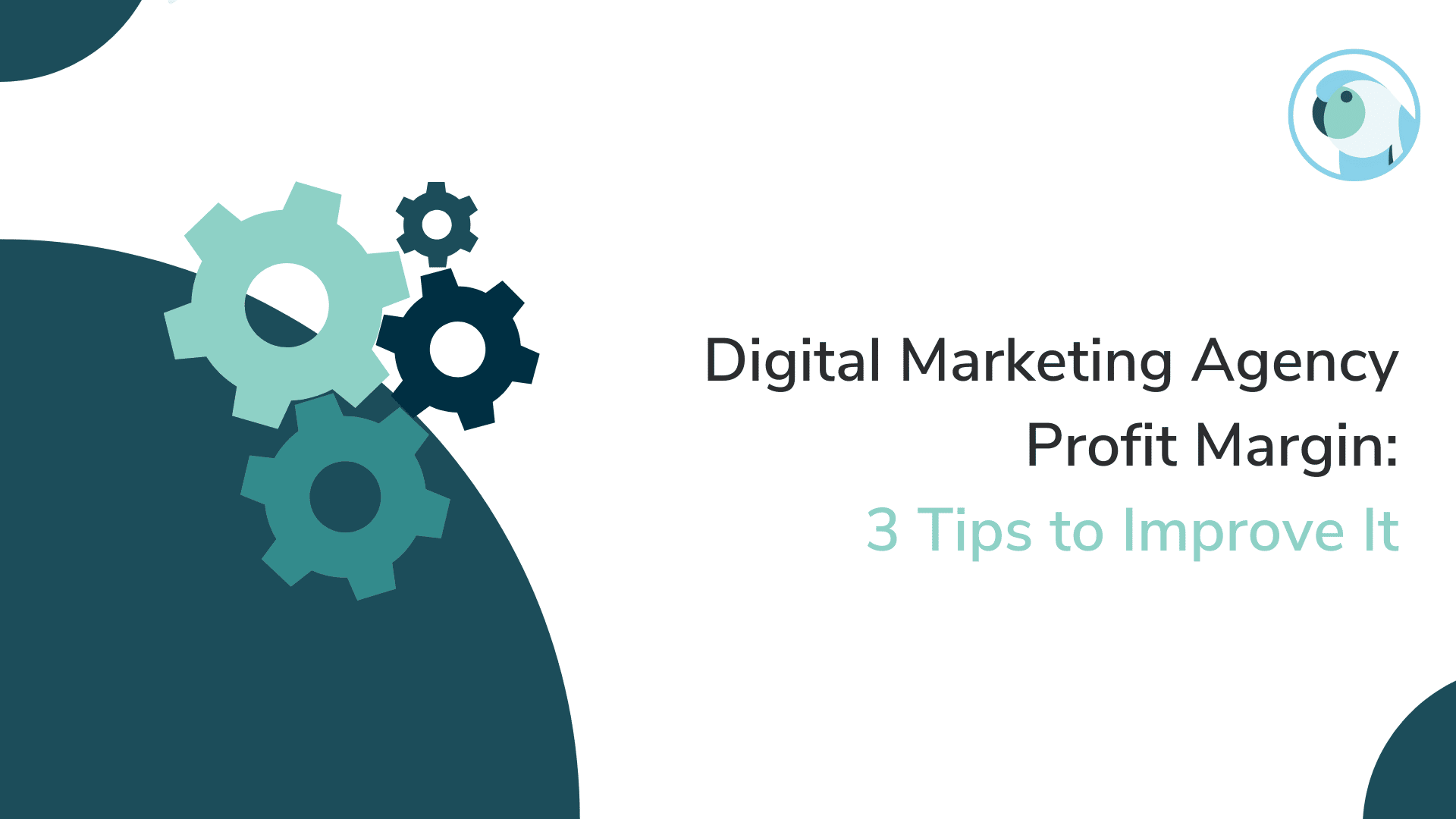


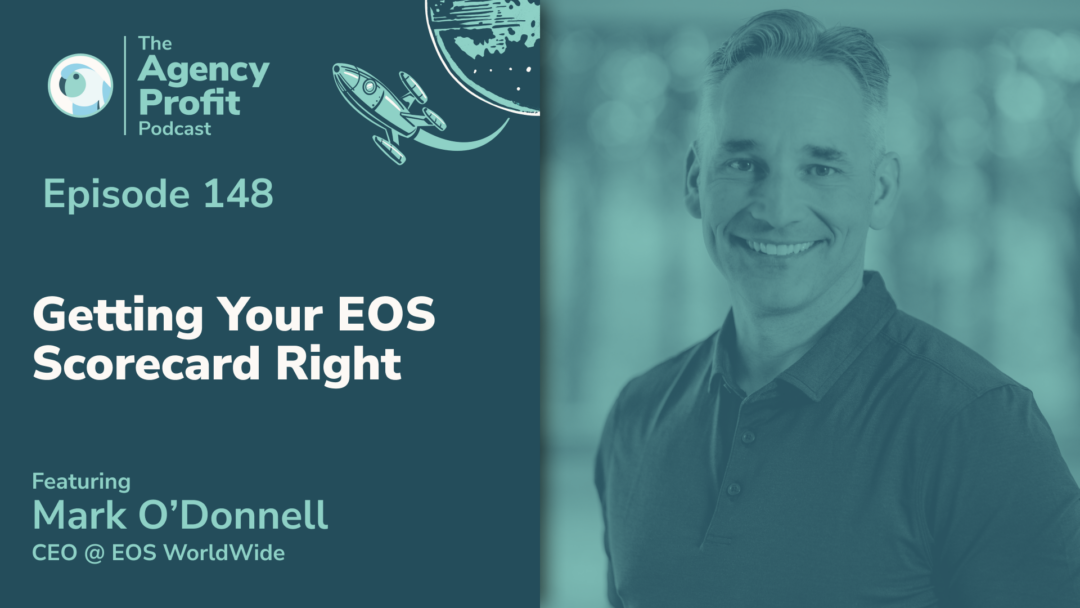



Great insights in this post! I particularly found the tips on streamlining processes and focusing on client retention very useful. It’s easy to overlook these aspects while chasing new business. Looking forward to implementing some of these strategies!
Great insights on improving profit margins! The tips you provided are practical and easily implementable. I especially appreciated the focus on tracking key metrics and refining service offerings. Looking forward to applying these strategies in my own agency!